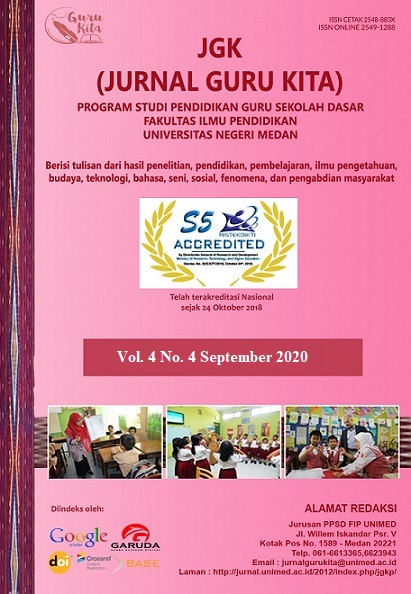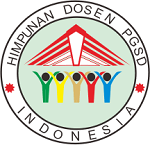PENINGKATAN PARTISIPASI AKTIF SISWA MELALUI PENERAPAN PENDEKATAN ILMU TEKNOLOGI MASYARAKAT (ITM) DALAM PEMBELAJARAN IPS DI SD KELAS TINGGI
DOI:
https://doi.org/10.24114/jgk.v6i2.28950Keywords:
Ilmu Teknologi Masyarakat (ITM), Partisipasi aktif siswa, IPS.Abstract
Abstract:Analysis of Increasing Student Active Participation through the Application of the Science Technology Society (STS) Approach in Social Studies Learning in High School Elementary Schools. The purpose of the study was to analyze the application of the Science Technology Society (STS) approach to determine the increase in students active participation in social studies learning in high school elementary schools. The research subjects are high school elementary school students, the sample taken is grade 4. The research method used is descriptive analysis of the type of study literature where the data collection process comes from secondary data literature. This study uses content analysis techniques (content analysis). The results of the study illustrate that there is an increase in student active participation through the application of the Science Technology Society (STS) approach in social studies learning in high school elementary schools. The Science Technology Society (STS) approach requires students to construct, identify, design, create, and implement their knowledge into new knowledge, which can be obtained by students from active participation during the learning process. Abstrak:Analisis Peningkatan Partisipasi Aktif Siswa melalui Penerapan Pendekatan Ilmu Teknologi Masyarakat (ITM) dalam Pembelajaran IPS di SD Kelas Tinggi. Tujuan penelitian adalah menganalisis penerapan pendekatan Ilmu Teknologi Masyarakat untuk mengetahui peningkatan partisipasi aktif siswa dalam pembelajaran IPS di SD kelas tinggi. Subjek penelitian yaitu siswa Sekolah Dasar (SD) kelas tinggi, sample yang diambil adalah kelas 4. Metode penelitian yang digunakan adalah analisis deskriprif tipe study literature dimana proses pengambilan data berasal dari literatur data sekunder. Penelitian ini menggunakan teknik analisis isi (content analysis). Hasil penelitian memberikan gambaran bahwa adanya peningkatan partisipasi aktif siswa melalui penerapan pendekatan Ilmu Teknologi Masyarakat (ITM) dalam pembelajaran IPS di SD kelas tinggi. Pendekatan ITM tersebut menuntut siswa untuk mengkontruksi, mengidentifikasi, merancang, mencipta, dan mengimplementasikan pengetahuan yang dimiliki ke dalam pengetahuan baru, yang dapat diperoleh siswa dari partipasi akif selama proses pembelajaran berlangsung.References
Abdullah. 2017. Pendekatan dan Model Pembelajaran yang Mengaktifkan Siswa. Probolinggo: Jurnal Edureligia Volume 1 No. 1, 2017.
Anastasia, A.D. 2018. Analisis Pendekatan ITM (Ilmu Teknologi Masyarakat) di Dalam Mengatasi Pembelajaran IPS pada Peserta Didik. Batam: Jurnal Dimensi Volume 7 No. 1 Maret 2018.
Peraturan Menteri Pendidikan dan Kebudayaan Nomor 22 Tahun 2016 tentang Standar Proses.
Peraturan Menteri Pendidikan dan Kebudayaan Nomor 21 Tahun 2016 tentang Standar Isi.
Prihantini. 2021. Strategi Pembelajaran SD. Jakarta: Bumi Aksara.
Wahyuningsih, Fitri. 2018. Penerapan Model Pembelajaran Ilmu Teknologi Masyarakat terhadap Hasil Belajar Siswa Kelas IV SDN Keboansikep. Sidaorjo: Universitas Muhammadiyah.
Yusmantara, U.S (2014). Penerapan Model œITM pada Pembelajaran IPS Pengaruhnya terhadap Pemahaman Konsep dan Keterampilan Sosial Siswa Sekolah Dasar. Bandung: Jurnal Eduhumaniora Volume 6 No. 1 Januari 2014.
Downloads
Published
How to Cite
Issue
Section
License
Authors published with the JGK (Jurnal Guru Kita) agree to the following terms:
- Authors retain copyright and grant the journal the right of first publication with the work simultaneously licensed under a Creative Commons Attribution License (CC BY-SA 4.0) that allows others to share the work with an acknowledgment of the work's authorship and initial publication in this journal.
- Authors are able to enter into separate, additional contractual arrangements for the non-exclusive distribution of the journal's published version of the work (e.g., post it to an institutional repository or publish it in a book), with an acknowledgment of its initial publication in this journal.
- Authors are permitted and encouraged to post their work online (e.g., in institutional repositories or on their website) prior to and during the submission process, as it can lead to productive exchanges, as well as earlier and greater citation of published work. (See The Effect of Open Access)


























